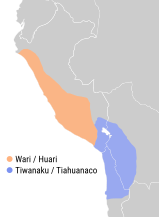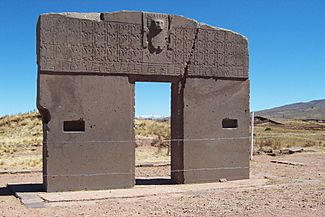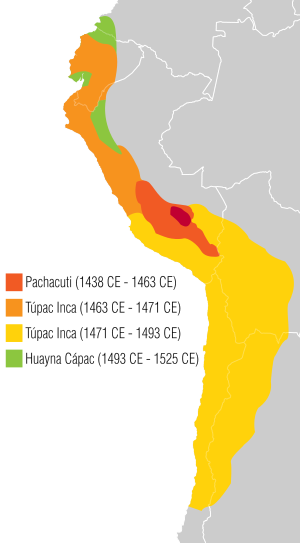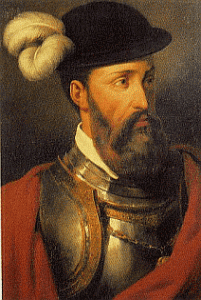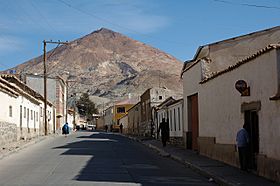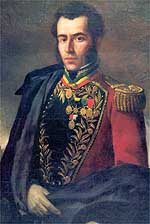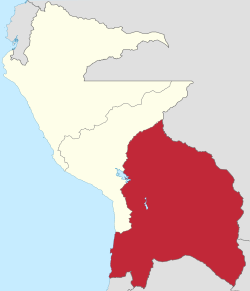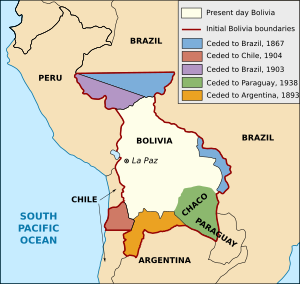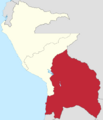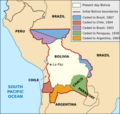History of Bolivia facts for kids
The history of Bolivia covers thousands of years of people living in the area.
Long ago, Lake Titicaca was a very important place for culture and growth. The Tiwanaku people built an advanced civilization. Later, the powerful Inca Empire took over their lands in the 1400s and early 1500s.
Soon after, the Spanish, led by Francisco Pizarro, conquered the Inca Empire in the early 1500s. The area that is now Bolivia became part of the Viceroyalty of Peru. It was known as Upper Peru. In 1776, Upper Peru was moved to the new Viceroyalty of Rio de la Plata, with its capital in Buenos Aires.
In the late 1700s, there was a big but unsuccessful uprising by indigenous people against the Spanish. It was led by Túpac Amaru II. Upper Peru joined the Spanish American wars of independence in the early 1800s. The country of Bolivia was formed in 1825 and named after Simon Bolivar. During the 1800s, Bolivia often fought wars with its neighbors. A big loss in the War of the Pacific meant Bolivia lost its access to the sea and valuable mineral fields.
Bolivia lost more land in the Chaco War against Paraguay in the 1930s. The Bolivian National Revolution started in the 1950s. It tried to take control of natural resources for the country and let more people vote. The country then had military rulers and many changes in government until the 1980s, when it became a democracy. However, the economy was still struggling.
In the 21st century, Evo Morales was a very important political leader until he stepped down during the 2019 Bolivian political crisis.
Contents
Ancient Times: Before Columbus
People in Bolivia developed unique cultures in the high altiplano region. This area has low oxygen, poor soil, and extreme weather. The lower lands were mostly home to groups who hunted and gathered food. Most people lived in the altiplano valleys of Cochabamba and Chuquisaca.
The potato was first grown near Lake Titicaca between 8000 and 5000 BC. Quinoa was grown about 3000–4000 years ago. People started making copper around 2000 BC. Animals like llama, alpaca, and vicuña were tamed. They were used for carrying things, food, and clothing.
The Aymara people arrived in the region about 2000 years ago. They settled in western Bolivia, southern Peru, and northern Chile. Today, Aymara people connect themselves to the advanced culture of Tiwanaku. After 600 CE, Tiwanaku became a strong regional power. At its largest, the city covered about 6.5 square kilometers and had many thousands of people.
Tiwanaku grew powerful through trade with other cities in its empire. It absorbed other cultures instead of destroying them. People in the Tiwanaku empire started using Tiwanaku pottery. The leaders of Tiwanaku became powerful by controlling extra food from other regions. They shared this food with everyone. They also controlled llama herds, which were important for moving goods. These herds also showed the difference between common people and leaders. The power of these leaders grew until about 950 CE.
After 950 CE, the climate changed, and there was much less rain in the Titicaca Basin. Tiwanaku disappeared around 1150 CE because there wasn't enough food to support the large population. The land was empty for many years after that.
Between 1438 and 1527, the Inca empire grew very quickly. Much of what is now western Bolivia became part of the Inca Empire. This happened under their 9th emperor, Pachacuti Inca Yupanqui. His son, Topa Inca Yupanqui, also expanded the Inca lands. During the 1400s, the Incas conquered the Lake Titicaca region. Western Bolivia became part of the Inca territory as the province of Qullasuyu.
Spanish Colonial Rule
Conquest by Spain
Francisco Pizarro, Diego de Almagro, and Hernando de Luque led the Spanish in finding and conquering the Inca empire. They first sailed south from Panama in 1524. They wanted to find a legendary land of gold called "Biru" (later Peru). The Inca Empire was growing fast but had internal problems, which made the conquest easier.
After the Inca Emperor Huayna Capac died in 1527, his sons Huascar and Atahualpa fought for control. Atahualpa won, but he hadn't fully taken power when the Spanish arrived in 1532. Atahualpa didn't try to stop Pizarro at first. He believed that those who controlled the mountains also controlled the coast. Atahualpa refused to accept the Spanish presence and become Christian. This led to the bloody Battle of Cajamarca on November 16, 1532. Pizarro captured Atahualpa. One year later, the Inca capital of Cuzco fell and became a new Spanish town.
Even with Pizarro's quick victory, Inca rebellions started soon after. They continued off and on during the time of Spanish rule. In 1537, Manco Inca, whom the Spanish had made a puppet ruler, rebelled. He created a "neo-Inca" state. This state challenged Spanish power even after the Spanish stopped the revolt and executed Túpac Amaru in 1572. Later revolts in the Bolivian highlands were usually local. But the great rebellion of Túpac Amaru II was different.
For the first 20 years of Spanish rule, the settlement of the Bolivian highlands was slow. This area was called Upper Peru (Alto Peru) or Real Audiencia of Charcas. There was a civil war between Pizarro's forces and Diego de Almagro's forces. They had divided the Inca territory, with Pizarro in the north and Almagro in the south. Fighting started in 1537. Pizarro defeated and executed Almagro in 1538. But Pizarro himself was killed three years later. Pizarro's brother, Gonzalo, took control of Upper Peru. But he soon rebelled against the Spanish king. Only after Gonzalo Pizarro was executed in 1548 did the Spanish king regain control. Later that year, the city of La Paz was founded. It quickly became an important trading center.
The Spanish conquest and rule were very hard for the indigenous peoples in Bolivia. Many died quickly from European diseases. However, indigenous people in the Bolivian lowlands resisted. They managed to delay the Spanish conquest of their lands. The Spanish founded Santa Cruz de la Sierra in 1561. But the Gran Chaco region remained a wild frontier. In the Chaco, Native Americans, mostly Chiriguano, attacked Spanish settlements and stayed independent.
Spanish Government
For most of the Spanish colonial period, this land was under the rule of the Viceroyalty of Peru. Local government was handled by the Real Audiencia of Charcas, located in Chuquisaca (modern Sucre). Bolivian silver mines produced much of the Spanish Empire's wealth. Potosí, home of the famous Cerro Rico ("Rich Mountain"), was one of the largest cities in the Western Hemisphere for a few centuries.
The wealth of Upper Peru and its distance from Lima led to a new court (audiencia) being created in Chuquisaca in 1558. Chuquisaca became very important as a center for Potosí's administration and food supply. The area under the court's control, called Charcas, first covered a large area around Chuquisaca. But it soon included Santa Cruz and parts of present-day Paraguay. The head of the audiencia had legal power and some administrative power. But bigger decisions were made in Lima. This situation led to a competitive feeling and a reputation for Upper Peru being assertive.
Spain's empire lasted a long time partly because of how well they managed the colonies. Spain first wanted to control the independent conquerors. But their main goal soon became making sure money kept flowing to the king. They also wanted to collect goods and labor from the Native American people. To do this, Spain created a complex government system in the New World. Different parts of the government watched over each other. Local officials had a lot of freedom. Spain controlled smaller areas through royal officials called corregidores. These officials represented the king in local governments chosen by citizens.
In the late 1700s, Spain made changes to its government to get more money and stop problems. They created a system of "intendancies." This gave a lot of power to skilled officials who reported directly to the king. In 1784, Spain set up four intendancy districts in Upper Peru. These covered the areas of present-day La Paz, Cochabamba, Potosí, and Chuquisaca.
Upper Peru became part of the new Viceroyalty of the Río de la Plata (with its capital in Buenos Aires) when it was created in 1776. The viceroy was helped by the audiencia (council). This council was also the highest court. If the viceroy was absent, it also had administrative power.
Christianity
Along with the Spanish conquerors came Catholic priests. They began to convert native peoples to Christianity. In 1552, the first bishopric (area led by a bishop) in Upper Peru was set up in La Plata. In 1605, La Paz and Santa Cruz also became bishoprics. In 1623, the Jesuits started the Royal and Pontifical Higher University of San Francisco Xavier of Chuquisaca. This was Upper Peru's first university.
The official Inca religion quickly disappeared. But Native Americans continued their local worship with the help of local Native American leaders. As Christianity grew, a new kind of folk Catholicism developed. It mixed in symbols from indigenous religions. Early Native American rebellions were against Christianity. But later revolts in the late 1500s used Christian symbols that were Roman Catholic but against the Spanish. The church was somewhat accepting of local Native American religions. In 1582, the bishop of La Plata allowed a church to be built for the dark Virgen de Copacabana near Lake Titicaca.
Native People's Rebellions
Many Native Americans adapted to Spanish ways. They broke with some traditions and tried to join the Spanish economy. They also used the courts to protect their rights, especially against taxes. Others held onto their customs as much as possible. Some rebelled against the white rulers. Local revolts happened throughout the time of Spanish rule. More than 100 revolts took place in the 1700s in Bolivia and Peru.
Native American anger against Spanish rule grew in the 1700s. Spain demanded higher taxes and more forced labor in the mines. This led to the great rebellion of Túpac Amaru II. He was born José Gabriel Condorcanqui. This educated, Spanish-speaking Native American took the name of his ancestor, Túpac Amaru. Túpac Amaru II said his movement wanted reforms, not to overthrow Spanish rule. But his demands included having an independent region. The uprising quickly became a full-scale revolt. About 60,000 Native Americans in the Peruvian and Bolivian Andes joined him. After some early victories, Túpac Amaru II was captured and executed in May 1781. But the revolt continued, mostly in Upper Peru.
There, a supporter of Túpac Amaru II, the Native American chief Tomás Catari, had led an uprising in Potosí in early 1780. Catari was killed by the Spanish a month before Túpac Amaru II. Another major revolt was led by Julián Apaza. He took the names of the two rebel leaders, calling himself Túpac Catari. He surrounded La Paz for over 100 days in 1781. During this time, 20,000 people died. In 1782, an Aymara woman, Bartolina Sisa, was executed for starting another revolt. Spain didn't stop all the revolts until 1783. Then, they executed thousands of Native Americans.
Fight for Independence
In the late 1700s, people born in the Americas but of Spanish descent, called criollos, became unhappy with Spanish rule. They were becoming more active in the economy, especially in mining and farming. They didn't like the trade rules set by Spain. Also, criollos were angry that Spain only gave important government jobs to people born in Spain (peninsulares).
Ideas from the Age of Enlightenment also made criollos unhappy. These ideas focused on reason, questioning authority, and individual freedom. Books by thinkers like Jean-Jacques Rousseau and John Locke were discussed by criollos, especially those educated at the university in Chuquisaca. Even though Upper Peru was mostly loyal to Spain, ideas of independence were talked about by small groups.
As Spanish royal power weakened during the Napoleonic Wars, the desire to be free from colonial rule grew. Independence was declared in 1809. But it took 16 more years of fighting before a republic named after Simón Bolívar was formed.
The invasion of Spain by Napoleon's forces in 1807-08 was key to the independence fight in South America. The overthrow of the Spanish royal family caused confusion in Upper Peru. Most people stayed loyal to the Spanish king. They supported the government in Spain that claimed to rule in the name of the king. Some criollos wanted independence for Upper Peru.
This led to local power struggles in Upper Peru between 1808 and 1810. This was the first part of the independence efforts. In 1809, there were revolts in Chuquisaca and La Paz. Both were put down by forces from Peru and the Río de La Plata.
For the next seven years, Upper Peru became a battleground. Forces from Argentina fought against royalist troops from Peru. Even though the royalists stopped three Argentine invasions, local fighters controlled parts of the countryside. They formed six major "republiquetas," or areas of rebellion. In these areas, local patriotism grew into a full fight for independence. By 1817, Upper Peru was mostly quiet and controlled by the Viceroyalty of Peru.
After 1820, conservative criollos supported General Pedro Antonio de Olañeta. He was from Charcas and refused to accept the return of the liberal Spanish Constitution. Olañeta believed these changes threatened the king's power. He refused to join either the liberal royalist forces or the rebel armies led by Bolívar and Antonio José de Sucre. Olañeta was killed by his own men on April 1, 1825. A special congress declared Bolivia an independent republic on August 6. They named the new republic in honor of Bolívar to gain his support for Bolivia's independence from Peru.
The 1800s
During the time Marshal Andrés de Santa Cruz was president, Bolivia had a very successful period. There was great social and economic progress. Santa Cruz got involved in Peru's political problems. He managed to unite Peru and Bolivia into one country, the Peru–Bolivian Confederation. Santa Cruz openly said the Inca Empire was a model for his state. This made other countries in the region feel threatened.
The War of the Confederation broke out. Bolivia fought wars against almost all its neighbors and won many battles. A key moment was at Paucarpata, where the Confederation forced the Chilean and Peruvian rebel armies to sign a peace treaty. This treaty included their surrender. However, the Chilean parliament later rejected this treaty. The rebel Peruvians and the Chilean army started a new war against Santa Cruz. They defeated the Confederation at the Battle of Yungay. This was a turning point for Bolivia. After this, the country faced many changes in government and short-lived constitutions for nearly 40 years.
Bolivia's military weakness was clear during the War of the Pacific (1879–83). In this war, it lost its Pacific coastline and rich nitrate fields to Chile. Later in the 1800s, the world price of silver went up. This brought Bolivia some wealth and political stability.
In the early 1900s, tin became the country's most important source of wealth, replacing silver. Several Liberal governments followed policies that allowed free markets during the first third of the century.
The 1900s
Early 1900s
Life for indigenous peoples, who were most of the population, was very hard. They were forced to work in dangerous mines and on large farms. They couldn't get education, economic chances, or take part in politics. Bolivia's defeat by Paraguay in the Chaco War (1932–1935) was a big change. Many lives were lost, and land was lost. This made the traditional ruling classes lose trust. Serving in the army also made indigenous people more aware of politics. In 1936, the Standard Oil company was taken over by the government. The state-owned oil company, Yacimientos Petroliferos Fiscales Bolivianos (YPFB), was created. From the end of the Chaco War until the 1952 revolution, new ideas and demands from new groups caused political unrest in Bolivia.
Bolivian National Revolution
The Bolivian National Revolution is one of the most important social and political events in Latin America in the 1900s. The Revolutionary Nationalist Movement (MNR) formed after the Chaco War in 1941. It was a political group of middle-class people who believed in nationalism, not Marxism. The MNR was part of the government from 1943–46. They won the 1951 elections, but the results were questioned, and they were not allowed to take the presidency.
On April 9, 1952, the MNR led a successful revolt. This started the Bolivian National Revolution. Under President Víctor Paz Estenssoro, the MNR allowed all adults to vote. They took control of the country's largest tin mines. They also carried out a big land reform and promoted education in rural areas.
The government tried to include Aymara and Quechua farmers (who made up over 65% of the population) in national life for the first time. Even though the MNR's policies aimed to bring people together, it was a big change in how Bolivia treated its indigenous people. After the 1952 revolution, the Bolivian government tried to be more involved in rural areas. They started a large public health campaign that included indigenous Bolivians.
Military Rule
After 12 years of changes, the MNR party became divided. In November 1964, a military group led by Vice-President René Barrientos overthrew President Paz Estenssoro. Many people say this ended the National Revolution and started nearly 20 years of military rule in Bolivia.
Barrientos was a popular general who spoke Quechua. He managed to get the support of peasant unions that formed after the 1953 land reform. This created a "Military-Peasant Pact." Throughout the 1960s, Barrientos used these peasant unions to control labor unrest in the mines.
Barrientos died in 1969, which led to a series of weak governments. The military took power in a coup, but then leftist Juan José Torres led a counter-coup in October 1970. His government faced pressure from other countries. Torres's power was also unstable because only a minority of the army and middle class supported him. Wealthy groups and parts of the army plotted against him. After less than a year, Torres was overthrown in August 1971. This was a bloody coup led by Colonel Hugo Banzer, supported by Brazil and the United States.
Banzer ruled with MNR support from 1971 to 1974. He then replaced civilians with military members and stopped political activities. The economy grew well during Banzer's time as president. But people wanted more political freedom. He called for elections in 1978, but problems with the voting caused more trouble in Bolivia. Elections in 1978, 1979, and 1980 were unclear and had fraud. There were many changes in government and temporary leaders.
In 1980, General Luis García Meza led a harsh and violent coup. His government was known for human rights abuses and poor economic management. This caused problems with the U.S., which refused to recognize García's government. García Meza was later found guilty of crimes, including murder. He was sent back from Brazil and began serving a 30-year sentence in 1995.
Return to Democracy
After a military rebellion forced García Meza out in 1981, three other military governments struggled with Bolivia's growing problems within 14 months. Unrest forced the military to bring back the Congress elected in 1980. This allowed Congress to choose a new leader.
From 1982 to Today
In October 1982, Hernán Siles Zuazo became president again. He had been president before. Serious social problems, made worse by poor economic management and weak leadership, forced him to call early elections. He gave up power a year before his term ended.
In the 1985 elections, the Nationalist Democratic Action Party (ADN) of General Banzer won the most votes. But no candidate won a majority. So, Congress chose the president. Paz Estenssoro was chosen for a fourth term as president. When he took office in 1985, he faced a huge economic crisis. The economy and exports had been shrinking for several years.
Prices were rising extremely fast, at an annual rate of 24,000%. Social unrest and strikes were common. In four years, Paz Estenssoro's government brought economic and social stability. The military stayed out of politics. All major political parties committed to democracy. Human rights problems, which had been bad earlier, were no longer an issue. However, these achievements came with sacrifices. Tin prices collapsed in October 1985. This forced the government to lay off over 20,000 miners.
In the 1989 elections, Gonzalo Sánchez de Lozada's party won the most votes. But no candidate got a majority. So, Congress chose the president. Jaime Paz Zamora became president. He was a moderate, center-left president. He continued the economic reforms started by Paz Estenssoro. Paz Zamora took a firm stance against terrorism.
The 1993 elections continued the tradition of fair elections and peaceful transfers of power. Sánchez de Lozada became president. He started an active plan for economic and social reforms. The biggest change was the "capitalization program." Under this, investors bought 50% ownership and control of public companies. These included the Yacimientos Petroliferos Fiscales Bolivianos (YPFB) oil company, phone systems, and electric companies. These reforms were strongly opposed by some groups. This led to frequent social unrest, especially in La Paz, from 1994 to 1996.
In the 1997 elections, General Hugo Banzer won the most votes. He formed a group of parties that had a majority in Congress. Congress elected him president, and he took office on August 6, 1997.
Cochabamba Water Protests (2000)
Between January and April 2000, there were protests in Cochabamba. People were against the privatization (selling to private companies) of the city's water supply. This was suggested by the World Bank and the International Monetary Fund. The Bolivian government declared a state of emergency. After continued protests, the government finally stopped the privatization on April 10, 2000.
2002 Presidential Election
President Hugo Banzer resigned in August 2001 because he had lung cancer. His vice-president, Jorge Quiroga, took over. In the 2002 presidential elections, Sánchez de Lozada ran again. He narrowly beat Manfred Reyes Villa and the indigenous leader Evo Morales.
A few days before the election, the U.S. ambassador warned Bolivian voters. He said that if they voted for Morales, the U.S. would cut off aid and close its markets to Bolivia. Despite this, Morales still received almost 21% of the vote.
The Gas War (2003)
In recent years, a big conflict was the Bolivian Gas War. This was a disagreement over how to use Bolivia's large natural gas reserves in the south.
Strikes and roadblocks first started in September 2003. There were deaths and injuries in clashes with the armed forces. President Gonzalo Sánchez de Lozada resigned because of pressure from protesters. He formally handed the presidency to his vice-president, Carlos Mesa, to keep the government working. Lozada left the country for the United States. Mesa became president and promised to address the protesters' demands. Facing more protests, he resigned on March 7, 2005. He later withdrew his resignation.
In May–June 2005, Mesa resigned again. In a quick meeting of Parliament, Mr. Eduardo Rodríguez Veltzé – the President of the Supreme Court – became president on June 9, 2005. Agreements were made to change the Constitution. This allowed for new elections for Parliament and President on December 4, 2005.
Evo Morales Becomes President (2005)
The problems in the political system helped lead to the rise of indigenous social movements. The MAS party, led by Evo Morales, became very popular. Morales was a former cocalero (coca leaf farmer leader). In the elections of December 2005, Evo Morales and MAS won easily with 54% of the votes. He became the first Indigenous Bolivian president in history.
On May 1, 2006, Evo Morales kept his promise to take control of most of Bolivia's natural gas fields for the country. Many indigenous Bolivians had wanted this for years. Troops were sent to occupy the gas fields and take control from foreign companies that same day. Many were run by Petrobras, Brazil's largest energy company. This change was expected to create tension between Morales and Brazilian president Luiz Inácio Lula da Silva. On October 29, 2006, the Morales government signed agreements with eight foreign gas companies, including Petrobras. These agreements gave the Bolivian national gas company a majority share in the gas fields, completing the nationalization.
In August 2007, a conflict called The Calancha Case happened in Sucre. Local citizens wanted an official discussion about moving the seat of government to Sucre. The people of Sucre wanted it to be the full capital, including the executive and legislative branches. But the government said this was not practical. Three people died in the conflict, and many were wounded. The result was that the constitution stated Sucre is officially the capital, but the executive and legislative branches remained in La Paz. In May 2008, Evo Morales signed the treaty to create the Union of South American Nations.
In February 2009, Evo Morales introduced a new constitution. This gave Bolivians of indigenous descent more economic and political rights.
Between 2006 and 2014, the average income per person doubled. The rate of extreme poverty dropped from 38% to 18%. Also, the Gini coefficient (a measure of income inequality) improved.
Evo Morales was re-elected in 2009. His second term continued leftist policies. Bolivia joined the Bank of the South and the Community of Latin American and Caribbean States. He was reelected again in the 2014 general election. On October 17, 2015, Morales became Bolivia's longest-serving president.
During the 2019 elections, the quick counting process was stopped. At that time, Morales was leading. This stop caused concern among opposition politicians. Two days later, the official count showed Morales had just enough votes to win without a second election. This started protests and tension.
After the disputed 2019 general election and the protests that followed, President resigned. He said he did so to "protect the families" of his party members. Morales went to Mexico and was given safety there. Morales and his supporters said the event was a coup. However, local investigators noted that even after Morales's resignation, his political party still controlled the Senate and House of Representatives.
Luis Arce Becomes President (2020)
After the 2019 Bolivian political crisis, Interim President Jeanine Áñez called for new presidential elections.
The elections took place on October 18, 2020. Luis Arce, supported by Evo Morales, won them. Arce was from the Movement for Socialism party. He had been the Minister of Economy and Public Finance in Morales's government.
On November 8, 2020, Luis Arce became President of Bolivia. His Vice President was David Choquehuanca.
On March 12, 2021, the government ordered the arrest of Jeanine Áñez, the former Interim President, and five members of her government. They were accused of involvement in a coup against Evo Morales in 2019.
According to the Bolivian Institute of Foreign Trade, Bolivia had the lowest accumulated inflation (price increases) in Latin America by October 2021.
Images for kids
See also
 In Spanish: Historia de Bolivia para niños
In Spanish: Historia de Bolivia para niños
- Charca people
- Bolivia–United States relations
- Bolivian War of Independence
- History of Bolivian nationality
- History of Latin America
- History of South America
- Viceroyalty of Peru


